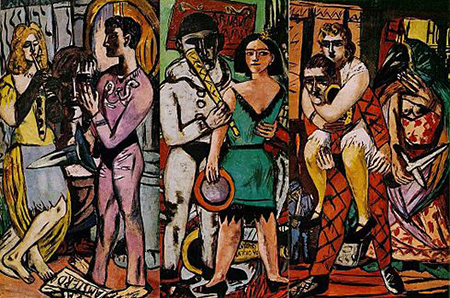
“… in the realm of pure concentration, your greatest enemies are the evils of the big wide world: motor cars, photographs, movies — all those things that more or less consciously take away from people the belief in their own individuality and their transcendent possibilities and turn them into stereotyped men.”
— Max Beckmann, Letter to a Woman Painter, 1948
It’s a brand-new year, and thus, according to tradition, time again for a brand-new you and me! Away with our aged avatars! I have never believed in the New Year’s resolution custom, which smacks too much of blithely optimistic self-invention, American-style. However, it’s also the time of the year for ten-best lists, so instead of taking on another of art critic Irving Sandler’s questions for his colleagues, as I have been doing occasionally in this space during the past couple of years now, I’ll post ten suggestions for a happier, healthier, more glowing life in 2015: tentative guides for the art-perplexed, so to speak, in the Max Beckmann Dutch-uncle mode. Full disclosure: I presented a slightly shorter version of this, accompanied by slides, at California State University, San Jose, last year.
1. There is no omniscient Orwellian Ministry of Truth in art, although many apparently believe that there should be. Artists create the work; critics and theorists interpret it. To assume that intellectual ideas precede visual creation is perverse and wrong-headed. We have to allow that a small percentage of interesting art might be exclusively theory-driven, and academic — nothing is impossible — but feeling and imagination are the real drivers of art, IMHO.
2. There is no Grand Unified Theory of art; there’s not even consensus about what art is in our pluralistic age, with its embrace of technology, mass culture and conceptualism. Everything is allowed now, but nothing is mandatory, as abstraction briefly was during the 50s and 60s. Artists are rightly free to do what they want — if they can determine what that is.
3. Explore whatever and however you want. Be professional and collegial to artists of all kinds, but don’t surrender in your art on the big issues. Let’s not be conformist. Creators create; curators only choose, arrange and write prettily (if not always with clarity). The current cult of the curator and the art administrator continues only because we tolerate it. Artists need to take back some power.
4. Financial success is fine (and good luck!), but watch out for money traps. When I wrote about the Oakland/Berkeley art scene years ago, I concentrated my efforts on the galleries that kept regular hours and were open to the public consistently. Beyond that I felt that helping to create a sustainable art market for worthwhile are being produced in the East Bay was a worthy mission. Artist-run spaces that did not conduct themselves professionally may have felt slighted, but I am pretty certain that I made the correct decision. To minimize sales-pressure creative paralysis, successful artists have always had to consider an art-related side job. That is, if they selected their parents poorly.
5. Art history is a rich guide to style and content. Know your ancestors; they’re there to help. Ben Shahn once dreamed that the great painters of the past gave him praise. Willem deKooning said art history is a rich soup that no artist should turn down. Do your homework and don’t be a fashion victim.
6. Beware of conformity to dogma. Don’t worry about being part of your time; that is a given, anyway. If your art is good, it will provide future viewers an entry into our time, as well as insight into their own.
7. Market yourself through social media (without undue narcissism), and have fun with fashion and other interests, but don’t get overly distracted. Eyes on the prize. Are you an artist or only possessed of “artistic temperament”?
8. Adhere to your standards, but eschew art snobbery. All artists are your colleagues. Don’t play the status-hierarchy game.
9. Be as insanely great as you can, but keep the ego human-sized. Take your work seriously; take yourself lightly.
10. Be a good art citizen: a team player as well as lone wolf. Create the community you want; institutions won’t do it for you. Work with people with integrity and good values. Never give up. Persist!
